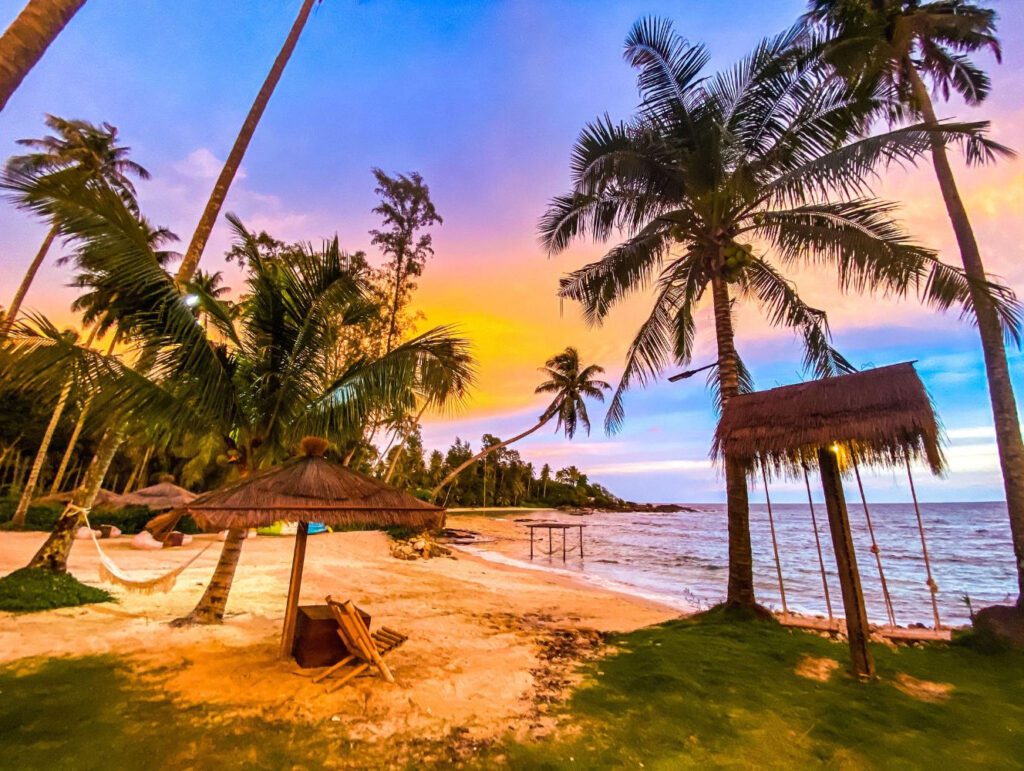
Discover Thailand’s Best Off-Path Destinations
When people ask me about visiting Thailand, most expect me to name the big cities—Bangkok, Chiang Mai, or Phuket—but the real hidden gems Thailand travelers should see lie far beyond those tourist routes.
As special as they are, those cities are just the cover of a much bigger book. If I really cared about you, I wouldn’t be sending you to these postcard cities — I’d be dragging you out to the real, authentic places instead.
The real story—visited only by locals and known by word of mouth—is found in lush, untouched valleys out of a storybook, quaint fishing towns that welcome you with open arms, and pristine hidden beaches that never make it into glossy social media reels (thankfully).
- Discover Thailand’s Best Off-Path Destinations
- Nan, Thailand: Cultural Haven in the Northern Valleys
- Pranburi & Sam Roi Yot: Phraya Nakhon Cave Adventures Beyond Hua Hin
- Koh Kood: Island Serenity Frozen in Time
- Uthai Thani: Hot Spring Escape Near Bangkok
- Chiang Dao: Northern Thailand at Its Purest
- Sustainable Travel Tips
- FAQ
- Ready for a trip that actually feels like yours?
As a second-generation Thai who doesn’t look like it, I can slip into local conversations, pick up dialects, and get directions to waterfalls or hot springs that never make it onto Google Maps. That’s how I end up in places like Nan, Pranburi, Koh Kood, Uthai Thani, and Chiang Dao—not through guidebooks, but through gas station chats, coffee shop banter, and the kind of word-of-mouth that only works if you speak Thai. One stormy day, I pulled into a Hmong strawberry shop on Mon Jam, and a five-minute chat turned into a lead on a hidden hot spring—down what might be the most scenic road I’ve ever ridden in Chiang Mai. By sharing these stories, I know I risk making these spots a little less hidden, but if that awareness helps sustainable tourism grow and supports families in provinces often overlooked, then I’d say it’s worth it.
These places aren’t just destinations. They’re really lifetime experiences—from the moment you get on the van or boat, the journey already starts as anticipation fills the air, and the experience may forever define your life as you are brought to mountain valleys that make you want to build a forever home, mystical caves where sunlight from the heavens illuminates an olden temple constructed by a Great King, islands where rainfall and community love feel like a sprinkle of hugs, hot springs that reset your mind, body, and spirit, and mountain villages where time ceases to exist.
Thailand isn’t just where I live—it’s where I was born.
From childhood adventures to spontaneous off-the-beaten-path journeys, I’ve learned to love discovering corners of the country that hardly make it onto travel blogs or Trip Advisor, and for good reason. Off Path Thailand is my way of taking you along, sharing the places, moments, and little wonders that have stayed with me, so you can experience them too. This is what I live for.
In this Legit Thailand Hidden Gems Guide 2025 by a local, I share my personal experiences as a second-generation Thai with five of my favourite destinations in Thailand that remain beautifully off the beaten path.
Please don’t think of it as a list, but more as an invitation to share with you the amazing wonder of the country I grew up in, experiencing the real magic that is Thailand.
These five hidden gems in Thailand are my favorites and top picks for anyone wanting to avoid the tourist crowds. Prefer beaches over mountains? Discover our full guide to Thailand’s hidden gem islands. Places like Nan, Koh Kood Island, and Uthai Thani are off-the-grid spots—so off-path that even many Thais from other provinces have yet to explore them. From sleepy lush valleys and secret hotsprings to unique Thai island culture and tucked-away eco-friendly resorts, these off-the-beaten-path destinations are where I’ve had some of my most unforgettable adventures, and I can’t wait for you to explore them! Love misty valleys and slow-paced mountain escapes? Discover our Northern Thailand Hidden Gems guide — a closer look at Chiang Dao, Nan, and other northern gems that show the authentic soul of the Thai highlands.
Nan, Thailand: Cultural Haven in the Northern Valleys
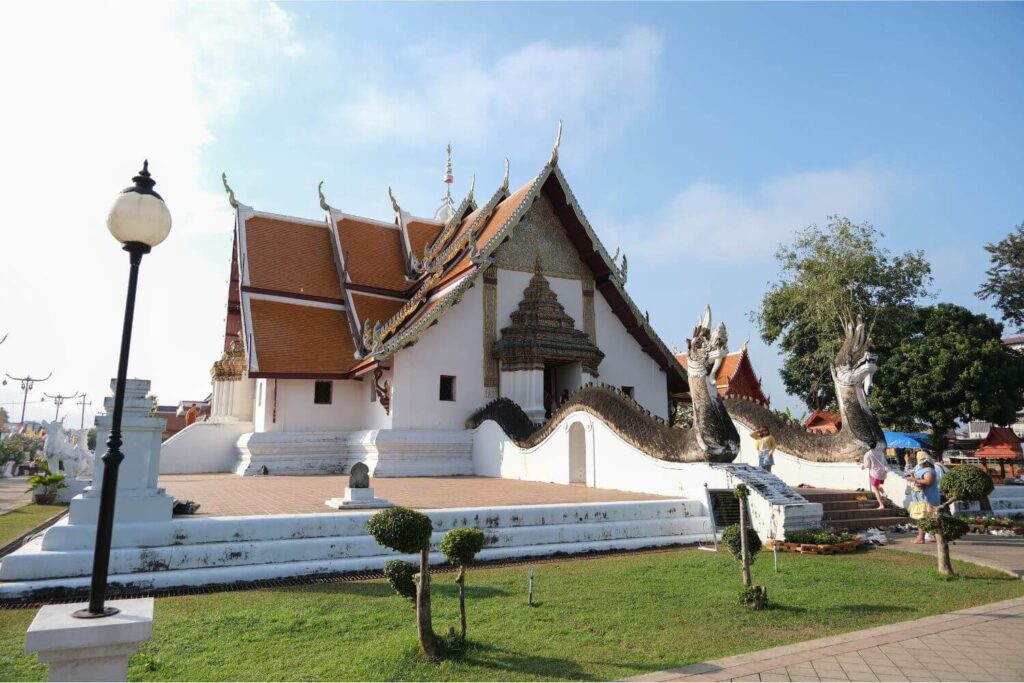
Nan, Thailand, is a slow-paced and chilled-out province, shaped by its history as a once-independent kingdom, which is rare to say about provinces in Thailand. Unlike bustling Chiang Mai, Nan, with authentic Thai culture only four hours away, moves at a much slower pace, carrying centuries of Lanna traditions evident by their language and mannerisms. The slow vibe makes Nan, Thailand, a must for off the beaten path travelers.
Wat Phumin, the most famous temple in Nan, is not grand because of its size but because of its intimacy and strong cultural ties to the history of Siam—paintings on its walls show daily life, Lanna couples, and people in traditional dress. Talk about Thai Cultural Experiences!
Why on Earth would people want to visit a temple swarmed with tourists when you could visit an authentic and peaceful temple like Wat Phumin? This is hidden gem travel in Thailand at its core.
In Nan, sustainable travel is easy as there are plenty of ways to keep your footprint small. Choosing homestays or eco-lodges means your money goes directly to families who preserve the Lanna culture you came to see, encouraging them to keep up with their warm hospitality, and also provide for their families. At Off Path Thailand we are big advocates for sustainable tourism. If you’d like to go beyond the usual tourist routes, I also organize private tours in Thailand focused on hidden gems, so you can travel deeper without the stress of planning.
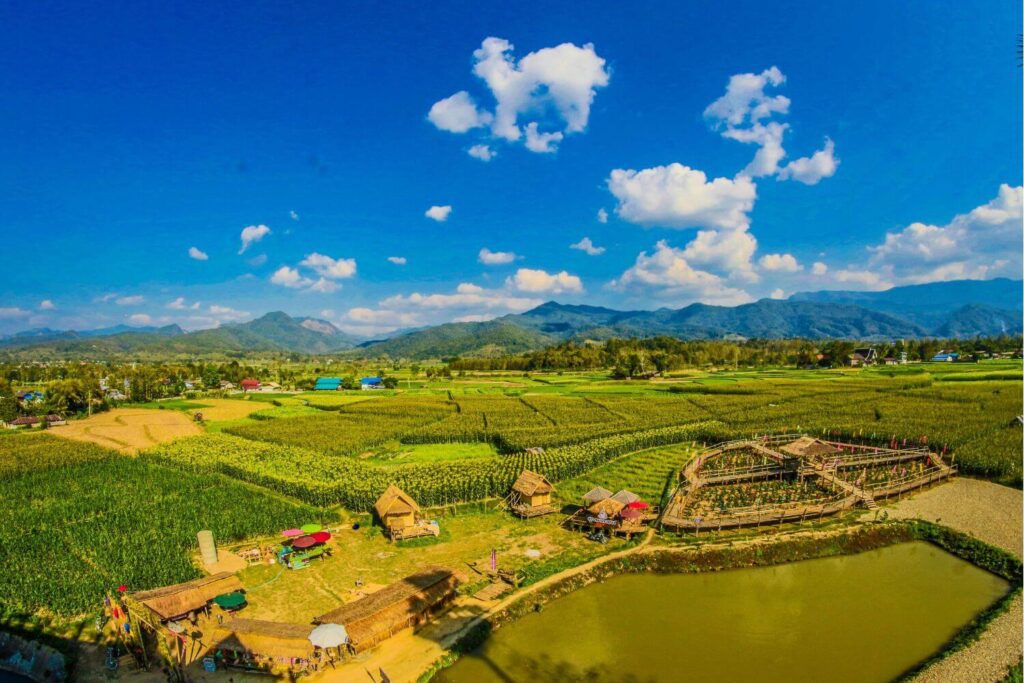
But it wasn’t just the temples that drew me to Nan, Thailand—it was the promise of adventure. A local juice-bar owner in Chiang Mai had shared a tip about a scooter journey that would lead me to the hidden Sapan Waterfall.
The first 50 km absolutely tested me—narrow roads leaving town, flat stretches, and scattered villages. I nearly turned back; it felt endless at first. But then, out of nowhere, the scenery opened into valleys that felt like they were out of a Jurassic Park film. I passed a rally of Mini Coopers; they waved like we were sharing a secret. Scootering to Sapan Waterfall is epic for serene and stunning views. Think Mae Hong Son Loop, but more picturesque.
The smell of wet earth and rice fields filled the air, and you could hear leaves moving in the breeze and roosters in the distant villages. At the valley before the waterfall, people spoke Lao-infused Thai, rice fields buzzed with life, and the air cooled down—and I felt that I was indeed off the beaten path. Happiness.
To be very honest, that valley was more than the waterfall itself. I ended up remembering it much more vividly than the actual waterfall. I could build a house here and never leave. Nan’s valleys make it one of those hidden gems in Thailand you can’t miss. I could have easily forgotten the waterfall, and that valley still would have made my trip!
Back in Nan town early in the evening, I literally collapsed on my bed, too tired even for dinner. That’s Nan—it takes effort, but it gives you moments that are eternal.
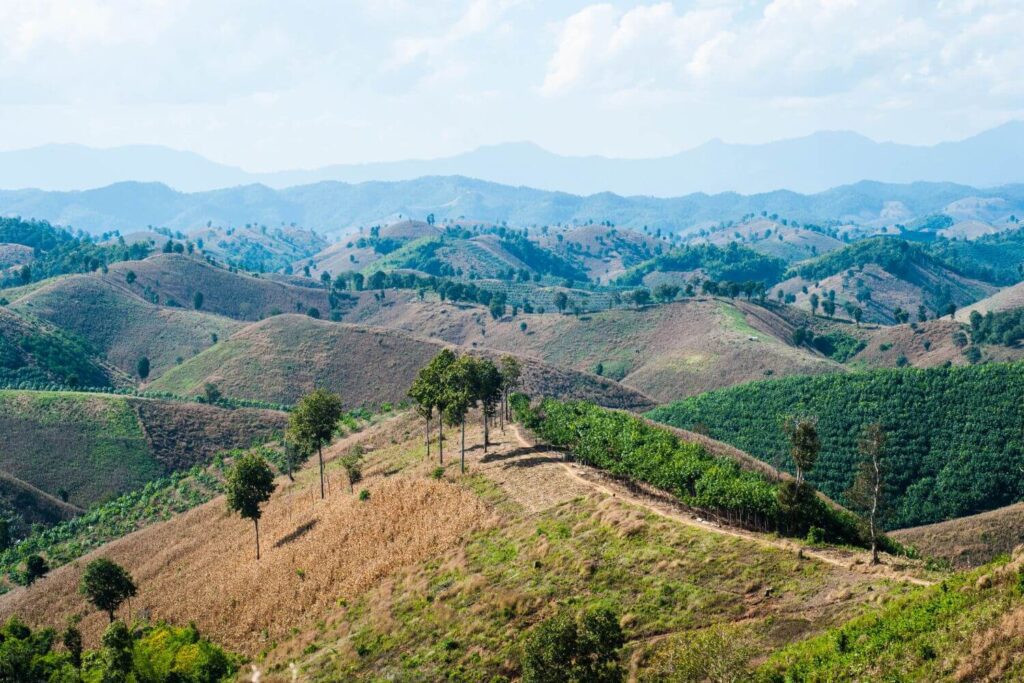
Map of Nan’s hidden gems & scenic routes to Sapan Waterfall.
Pranburi & Sam Roi Yot: Phraya Nakhon Cave Adventures Beyond Hua Hin

For years, I thought I knew Hua Hin. When I was younger, my family vacationed there regularly—we stayed in the same old place, ate at the same restaurants, and walked the same beach. It was relaxing, and routine.
But during COVID, some years later, in my early thirties on a solo trip, I decided to keep driving south, and that small decision changed everything.
A lakeside neighborhood encircled by mountains, Khao Tao (not to be confused with Koh Tao) popped out like a hidden painting masterpiece: the neighborhood surrounded by mountains, beaches stretching quietly, and locals who seemed relaxed and charming.
After a walk around the large serene lake, I visited the seaside cave temple on the hill, Wat Tham Khao Tao, followed by a 20-minute trek down to the beach. From there, I casually drove along the coastal scenic road, which led me to Khao Sam Roi Yot National Park, Thailand’s first coastal park.
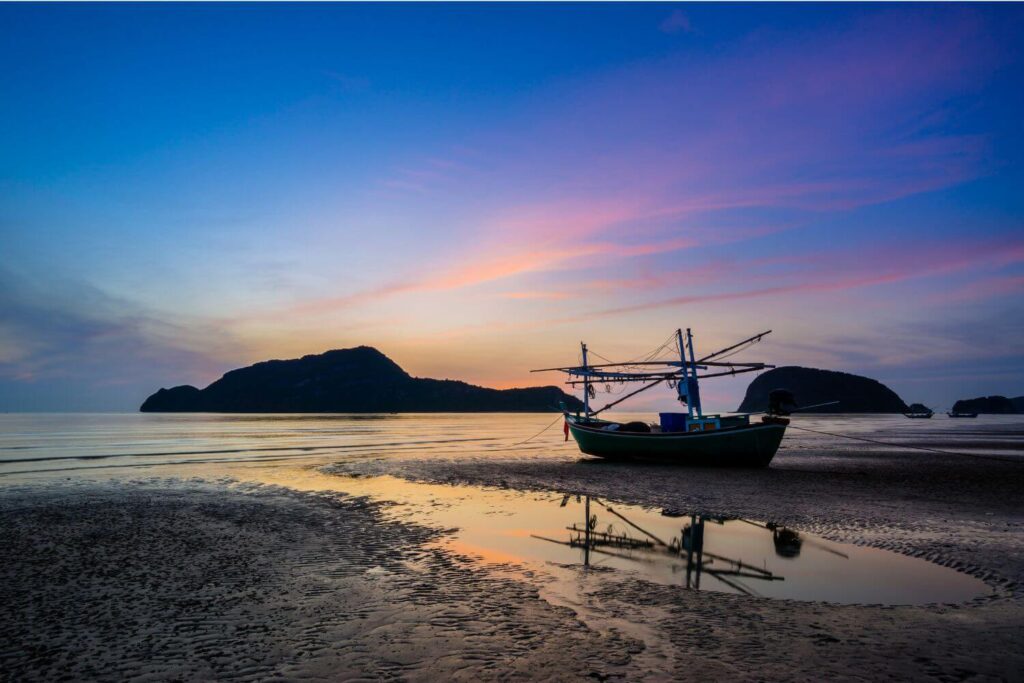
In Pranburi, Thailand, sustainable travel often starts with local food and lodging. Many boutique eco-lodges Thailand run on solar energy and partner with local fishermen for fresh seafood. Just by staying and dining local, you’re enabling the friendly community that safeguards Sam Roi Yot’s caves and the Pranburi area from mass tourism.
Inside the park, I hiked to two of its remarkable caves in flip-flops because I had no idea that this would be my day, including Phraya Nakhon Cave, a place I’d only ever seen in postcards and had completely forgotten existed. You can discover our Pranburi tours for similar off-path coastal experiences. Phraya Nakhon Cave was more of a proper workout than anything else—the climb was steep, but the temple and the light streaming in made it worthwhile. A cherished memory for life, especially as it was completely unplanned—proof that some of the most fun activities in Thailand happen when you least expect them.
Inside Phraya Nakhon Cave, a tiny royal temple pavilion built by King Chulalongkorn the Great (Rama IV) sits right under a natural opening, where sunlight streams down dramatically during the first few months of the year. Luckily, I visited in January, and standing there felt almost mind-blowing—nature and human creativity coming together to build the most beautiful Thai temple pavilion I’ve ever laid eyes on. I later rode to and climbed Khao Daeng Viewpoint for sunset. What a view—check out my video of my hike!
Earlier that day, I hiked and passed through Kaew Cave, a much smaller cave where the hike was trickier and felt dangerous at times (remember I was in flip-flops), but I honestly have never felt more alive climbing the narrow passages and uneven rocks. The Sam Roi Yot National Park Thailand ticket you get is valid and gives you access to all of the points I visited and more!
Pranburi’s caves are truly hidden gems in Thailand most tourists don’t even hear about. Most holidayers never go past Hua Hin, which allows Pranburi, Thailand to maintain its hidden gem status. Here, the waters are much clearer, the air fresher, and the people calm. It’s also absolutely an ideal spot for cycling, jogging, or just cruising along the coastal roads with no destination planned.
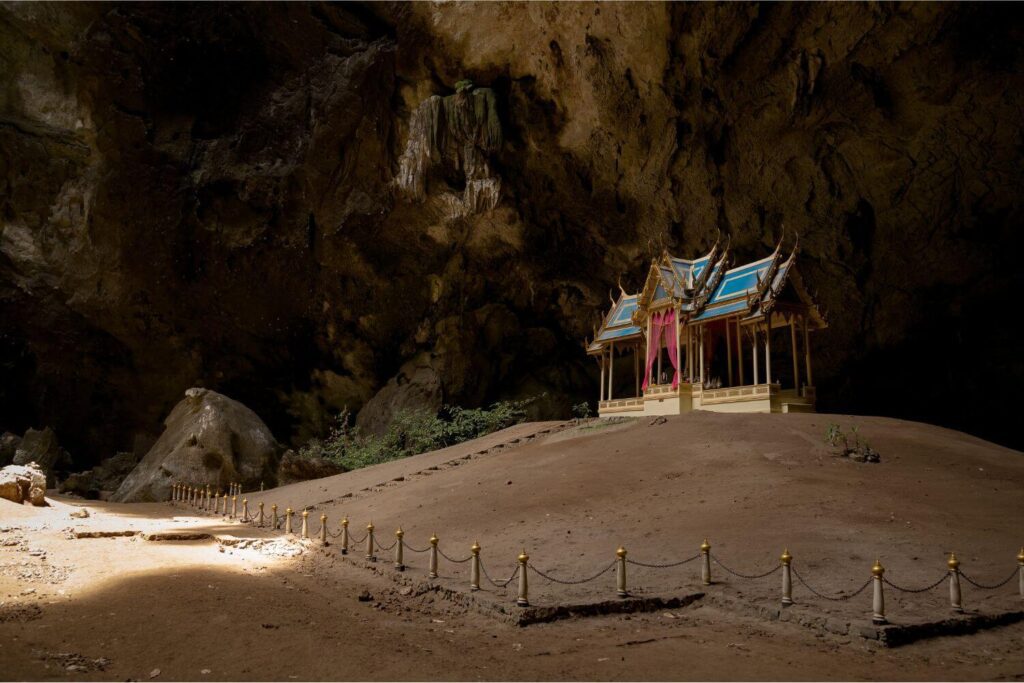
Map of Pranburi’s Sam Roi Yot National Park & Phraya Nakhon Cave.
Koh Kood: Island Serenity Frozen in Time

I first heard of Koh Kood, Thailand while on my routine getaway trip to Koh Samet. I used to go to Koh Samet three or four times a year with my mates, as it is only a short drive from Bangkok and the waters are nearly as blue and clear as the southern part of the country.
On one of my solo trips, a bartender, half-joking, told me: “If you are bored of Koh Samet, go to Koh Kood, Thailand for really paradisiacal ocean and sunset views.” You guessed it—the next morning, I was on a bus to Trat.
Arriving on the island in the rain, I expected disappointment. Instead, it felt like a warm hug. The family-owned resort room was cozy, the owner and his family cheerfully welcomed me, and the island was alive with community spirit. One night, I was invited to join a rotating party where locals and expats shared food and music—everyone took turns hosting at their hotels or bars. This kind of island community vibe is something I’ve only ever found on Koh Kood; it really felt like family.
When the rain cleared a day or two later, I rented a scooter from my resort and explored. The sea was a startling blue, calmer and more tranquil than Koh Samet for sure. Koh Kood, Thailand, remains one of the best hidden gem islands in Thailand. I trekked to the Klong Chao Waterfall, dipped in the lagoon, observed a giant Macca tree in the jungle that is estimated to be around 500 years old, and visited Ao Salat floating village, where families fish, trade, and paddle between houses as they’ve done for generations.
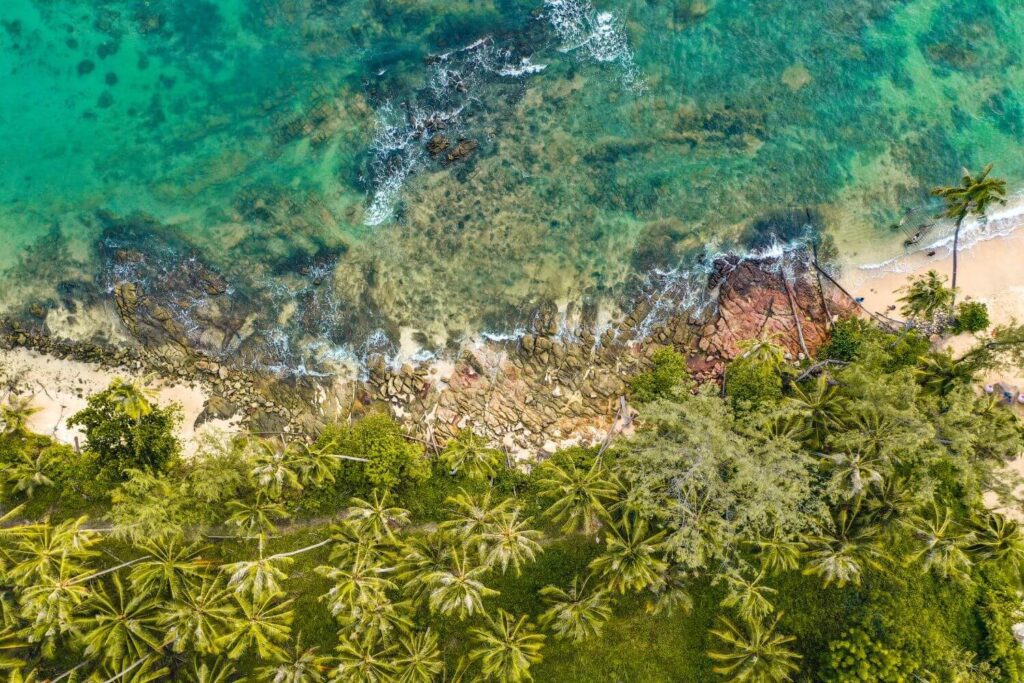
Sustainable travel in Thailand feels natural on Koh Kood because it has resisted heavy development. Luxury here doesn’t only mean resorts—it means quiet eco-lodges in Thailand built with natural materials, and fresh seafood bought directly from Ao Salat village. That’s how sustainability feels authentic while supporting island livelihood.
Koh Kood is a hidden gem because it resisted modernization (for the better). No airport, no big commercial resorts, no McDonald’s, no rush. It reminded me of how relaxed and pristine the likes of Koh Samui might have been decades ago.
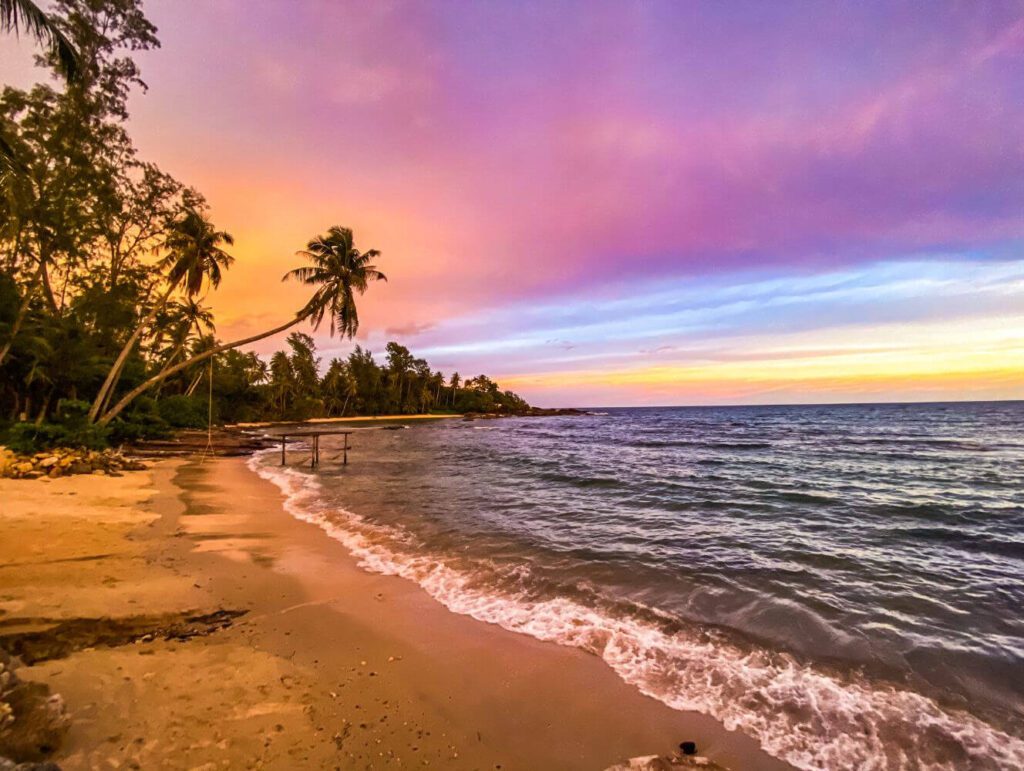
Map of Koh Kood
Uthai Thani: Hot Spring Escape Near Bangkok

For months, back living in the dusty and noisy Bangkok, I’d been badly craving a trip to Chiang Dao just to soak in hot springs and ride a scooter in nature. But the long travel, arranging flights, extra time off, and the additional expenses made it feel more like a luxury than a spontaneous escape. I badly craved a hot spring experience, yet all the logistics kept holding me back—until I stumbled upon Uthai Thani, Thailand.
Arriving in the town, it looked ordinary, simple, and unassuming, reminiscent of my visit to Nan, but with virtually zero tourism. But the very moment I hopped on my rented scooter and started the ride to the hot springs, everything changed. Rolling hills, quiet country roads, fields of lush greenery, and mountains rising in the distance unfolded before me. Each turn revealed another scenic surprise, and the freedom of riding through this peaceful landscape set the perfect tone for a change from Bangkok, one might say.
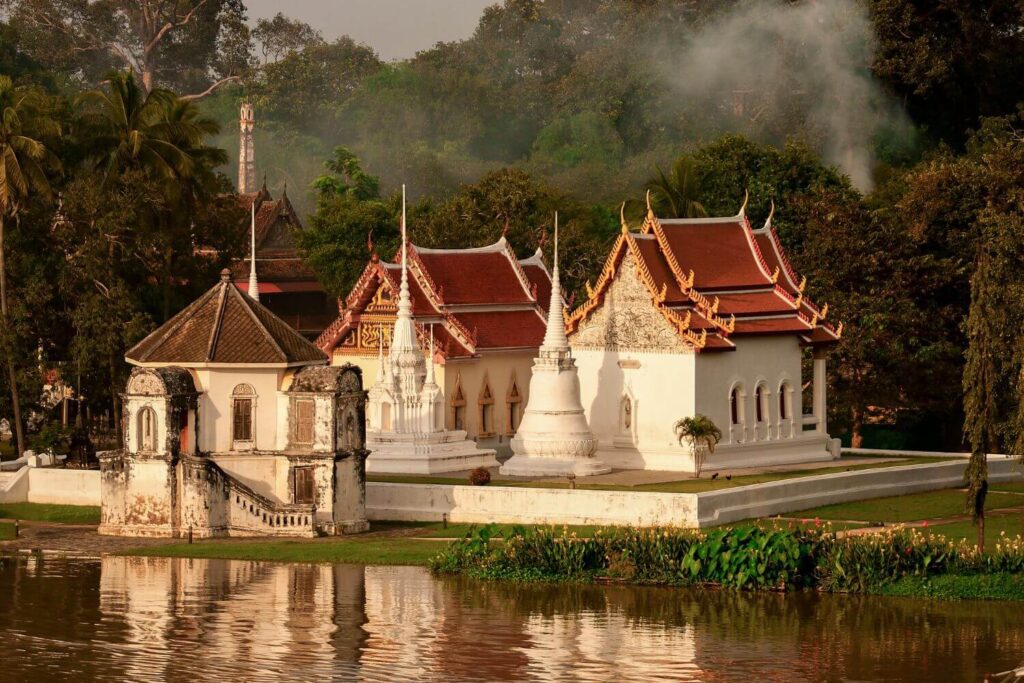
What makes Uthai Thani, Thailand one of the true hidden gems near Bangkok is how easily you can travel sustainably here. Family-run hot springs and guesthouses replace commercial and government chains, and even buying a meal at the tiny restaurant overlooking a lake on the property supports locals directly. This is what sustainable travel in Thailand looks like.
By the time I reached the hot springs, the property’s magic was immediately clear. The caretakers at the springs were charming, chatting casually as they tended the garden. They were nevertheless surprised to see a non-Thai-looking face in the vicinity.
I soaked in the warm, mineral-rich waters, and all my city stress melted away—leaving me completely rejuvenated.
At the springs, you can choose from different bath options starting at 30 baht, or book a larger room if visiting with a group. The water, like most other hot springs in Thailand, has a strong sulphur smell—think rotten eggs—but it’s packed with essential minerals. Make sure to take a proper shower after your soak. I brought my smartphone and played some relaxing classical tunes as I soaked for the next 20 minutes.
For me, that’s what makes Uthai Thani, Thailand one of Thailand’s ideal hidden gems—near Bangkok, quiet, authentic, and actually unforgettable once you have been there. Most travelers tend to skip it for Ayutthaya or Kanchanaburi when travelling closer to Bangkok, mainly because they have simply overlooked it, which is exactly why it remains such a perfect escape. Just three hours from Bangkok—close enough to be convenient, yet far enough from the crowds to feel like a true hidden gem.
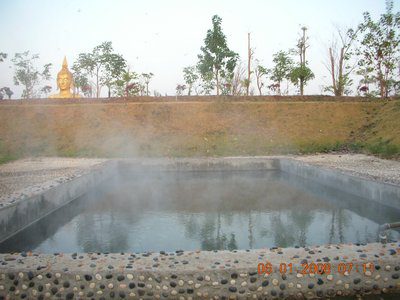
Map of Uthai Thani & Samo Thong Hot Springs
Chiang Dao: Northern Thailand at Its Purest
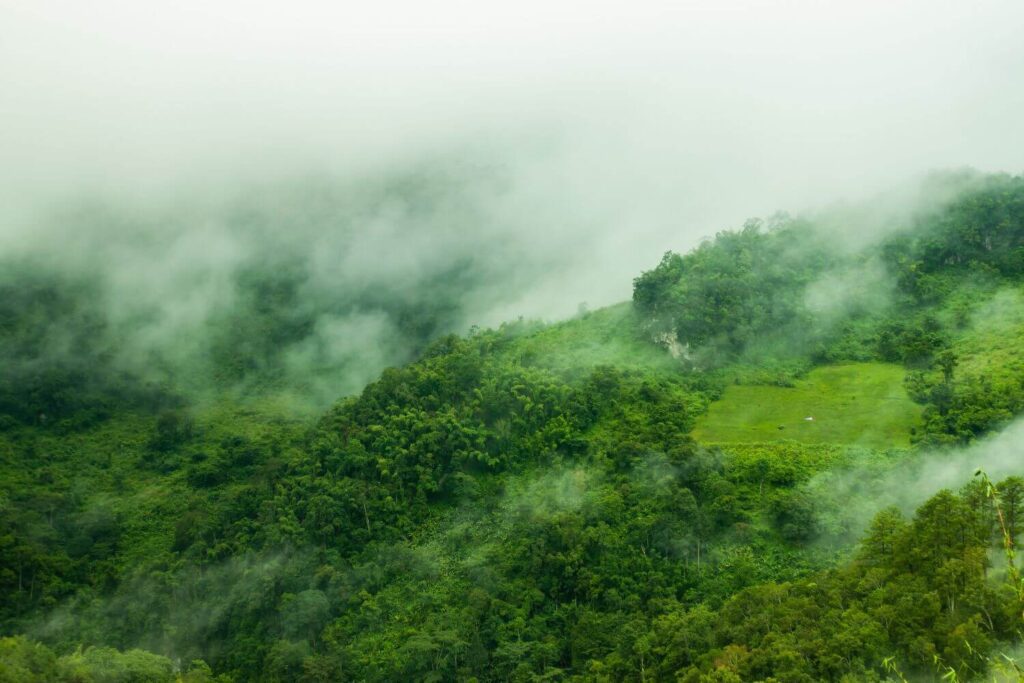
If there’s one place in Thailand that I can safely call my favourite, it’s Chiang Dao, Thailand. Just an hour north of Mae Rim, Chiang Mai, this humble town sits at the bottom of Doi Luang, a stunning mountain that has been declared a UNESCO Biosphere Reserve.
Chiang Dao literally translates into the “City of Stars”—and the night sky here truly doesn’t disappoint.
Mornings are misty and freezing. Limestone cliffs rise quietly in the background. Exploring the 300-million-year-old Chiang Dao Caves was another highlight, offering a deep sense of history and spiritual significance that makes this area one of Thailand’s hidden gems! Exploring the huge limestone chambers, you get a real sense of the history and local importance for Buddhism and these natural wonders Thailand is so fortunate to possess. Chiang Dao’s caves are hidden gems in Thailand for a reason, probably the nicest cave I’ve seen in all of Thailand, including the many caves I’ve visited in the coastal provinces.
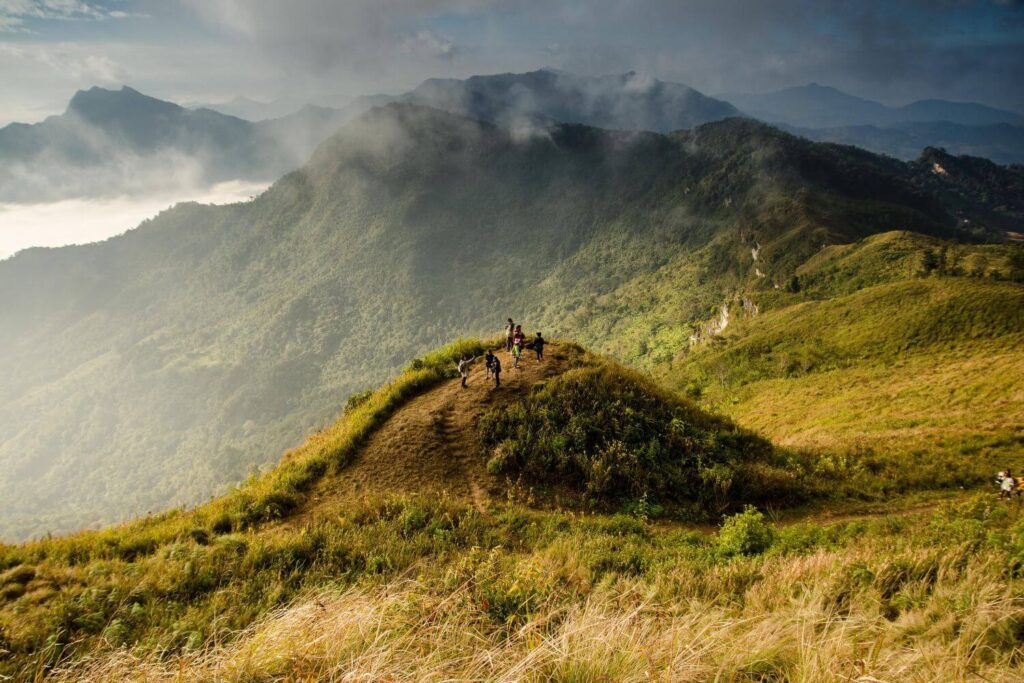
For sustainable tourism in Thailand, look for eco-lodges Thailand that use bamboo architecture and source meals from nearby farms practicing permaculture. Local markets can thrive when travelers choose local produce over 7-11, and that kind of support helps ensure these hidden gems in Thailand stay inspired for the next generation.
I’ve spent many evenings soaking in Chiang Dao’s hot springs at sunset, letting the warm water replenish the minerals from daily life. Scootering around the area, winding through lush valleys and peaceful roads, was the kind of reset that the islands just can’t give me.
Most travelers skip Chiang Dao, Thailand, heading straight for Chiang Mai or Pai instead. But that’s exactly what makes it special. Roads wind endlessly, valleys stay untouched and stunning year-round, and Thailand wildlife is protected by places such as Chiang Dao Wild Life Sanctuary.
If you’re there in November or December, Chiang Dao coincides with Yi Peng (lantern festival) like Chiang Mai, featuring sky lanterns and krathongs, making it a notable off path spot for Thailand festivals.
For me, Chiang Dao is the first place that comes to mind when I think of northern Thailand. The mist, the mountains, and the valleys here are the image I’ll always carry of the town.
Planning Your Off-Path Thailand Adventure
Reading about these hidden gems in Thailand might make you think, “I can just book a flight and figure it out myself.” But the experiences I offer go far beyond standard travel planning. When you’re ready to sit by quiet shores instead of misty valleys, explore our hidden gem islands collection.
Every journey—custom or pre-set—offers a once-in-a-lifetime adventure through Thailand’s most off-the-beaten-path corners: remote valleys like Nan, secret hot springs in Uthai Thani, mystical caves in Sam Roi Yot, tranquil beaches on Koh Kood, and authentic Thai encounters that most travelers never even experience but should.
Local tips like unheard of hotsprings come naturally from my Thai-born perspective, giving you access to moments that most tours will miss.
Every detail is arranged for you—from hotel pick-ups, coffee shop tips, and restaurant meals to private drivers and expert guides—so you can relax entirely and enjoy the journey.
With us you’ll experience misty mountains at sunrise, dip in secret waterfalls, join local festivals, and stay in resorts where your presence directly supports local families preserving their traditions—an essential part of sustainable travel in Thailand.
These tours are for travelers who value experiences over possessions, who crave stories, adventures, and connections that last long after the trip ends connecting with the soul of the country.This isn’t just a vacation—it’s an epic adventure designed to create memories, insights, and experiences you’ll treasure for a lifetime. And if planning it all feels overwhelming, know that a custom Thailand itinerary or exploring with a private guide in Thailand can make these hidden gems easier to reach, while keeping the experience just as authentic.
For a deep dive into the region’s cultural capital, see my complete guide on things to do in Chiang Mai.

Map of Chiang Dao & the world famous Chiang Dao Caves.
Sustainable Travel Tips
Sustainable travel in Thailand doesn’t need to be complicated. Start by choosing small eco-lodges and local homestays in places like Nan, Pranburi, and Koh Kood — where your stay directly supports families preserving Thai culture. Whenever possible, use shared transfers or community-run tours to keep your footprint light.
Learn more about our values and approach to responsible travel on our Sustainable Tourism page.
FAQ
What are the best hidden gems in Thailand for 2026?
Hidden gems in Thailand include places like Nan’s misty villages and Koh Kood’s untouched beaches. These quiet regions offer authentic experiences with local people and eco conscious stays, perfect for travelers seeking calm and natural beauty far from the crowds.
Where can I find off the beaten path Thailand destinations?
Off the beaten path destinations include Chiang Dao’s serene caves and Prachuap’s peaceful coastline. Local guides help you explore lesser known villages, markets, and trails, blending cultural immersion with responsible travel practices for a meaningful journey.
Are private tours in Thailand worth it?
Private tours are worth it if you want a personalised and authentic experience. Routes through places like Uthai Thani’s hidden hot springs or Nan’s countryside offer local insight, flexible itineraries, and quiet eco lodges that larger tours rarely reach.
How can I travel sustainably in Thailand?
Sustainable travel in Thailand includes staying in eco conscious lodges, choosing low impact transport, and supporting local communities. Areas like Koh Kood and northern Thailand offer community led experiences that help preserve the region’s natural and cultural heritage.
What makes Thailand’s hidden gems unique?
Thailand’s hidden gems stand out for their quiet beauty, cultural depth, and authentic local life. Places like Nan’s ancient temples or Koh Kood’s pristine shores offer meaningful encounters guided by people who know the land, revealing a version of Thailand untouched by mass tourism.
Tell us your dates and vibe — we’ll build it in 24 hours.
Ready for a trip that actually feels like yours?
Every journey leaves a footprint — the difference is in how we choose to travel. At Off Path Thailand, we focus on keeping those footprints light. Discover how sustainable travel in Thailand connects comfort with care.
